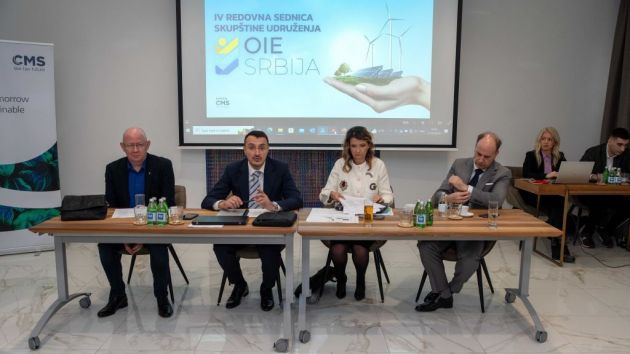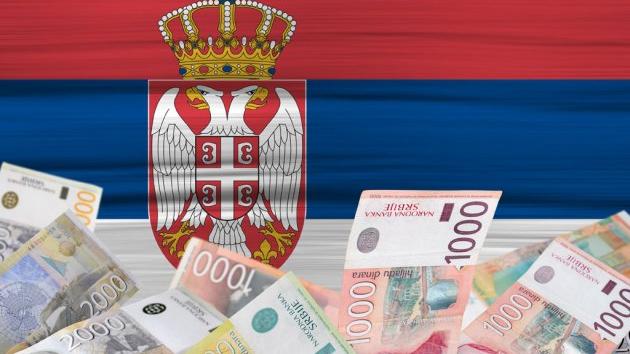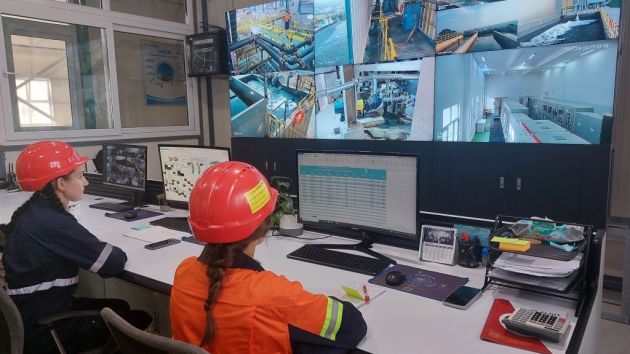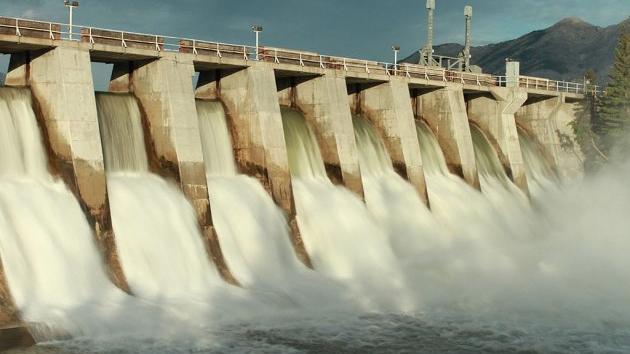Dusan Zivkovic, Acting Director of EPS – We Will Invest EUR 5.4 Billion in RES Projects by 2030
(Photo: OIE Srbija)

Dusan Zivkovic, the acting director of EPS AD, points out that Serbia’s biggest energy company is historically connected with RES, because the first hydro power plants, “Pod Gradom” and “Vucje”, over a century old, still work within EPS. The HPP “Pod Gradom” on the Djetinja in Uzice was put into operation in 1900 and was the first power plant in Serbia to operate according to Tesla’s principle of polyphase currents. The first transfer of electrical energy in Serbia was done from the small hydro power plant “Vucje” to Leskovac, by a 17-km power line. The power plant started working in 1903, for the needs of the famous weaving facilities of the “Serbian Manchester” and to light Leskovac.
How many RES power plants does EPS AD have in its portfolio? What is the total power of the power plants which use RES for the production of electrical energy? What is the share of RES in EPS’s portfolio?
– Hydro energy is the pride of Elektroprivreda Srbije and, with a power of 3,026 MW, EPS’s hydro power plants have an important role in the company’s production mix. EPS has 16 hydro power plants with 51 hydro generators, one reversible hydro power plant with two generators, one pumping facility with two pumps and 16 small hydro power plants, as well as one solar power plant with an installed power of 330 kW. Thanks to the good hydrology and high reliability of all the generators, records were broken in 2023 when it comes to the production of green kilowatts. The production was 41.3% higher than in 2022, and the annual production plan was exceeded by 13%. Last year, the hydro power plants produced the high amount of 12,665 GWh, that is, more than 12 billion kilowatt-hours of electrical energy, whereby the share of green, hydro energy, in the total production reached 36.5%.
EPS’s portfolio, when it comes to RES, is based on hydro power plants, but we are developing new projects and will continue to do so. At the moment, the construction of the wind farm Kostolac, with a power of 66 MW, and the solar power plant Petka, with a power of 10 MW, are in the final phases and they will contribute to an increase of the share of RES in EPS’s production portfolio.
Hydro power plants contribute the most to the production of electrical energy from RES. What is the condition of our hydro power plants like, considering that some of them are over half a century old? What is EPS doing to modernize them and extend their life cycle?
– EPS is working diligently on improving the operations of the hydro power plants, the extension of their life cycles and the increase of their efficiency. Regardless of whether there is an energy crisis or not, each megawatt-hour produced from water is useful in multiple ways. EPS has approached the revitalization of the HPPs with a plan and the revitalization of the HPP “Bajina Basta”, the HPP “Zvornik”, the HPP “Djerdap 1” has been completed, and the revitalization of the reversible HPP “Bajina Basta” is in progress and should be done in the next two years.
The revitalization of “Vlasina HPPs”, the HPP “Bistrica”, the HPP “Potpec” with an extension of the fourth generator, as well as the HPP “Djerdap 2”, is planned. The project documentation has been prepared for all the projects, and grants of EUR 16 million and EUR 7.5 million have been approved for “Vlasina HPPs” and the HPP “Bistrica” through the Western Balkans Investment Framework. We also expect this kind of help for the projects of the revitalization of the HPP “Potpec” and the HPP “Djerdap 2”, a total of around EUR 60 million for both projects. “Vlasina HPPs” are the closest to the beginning of the revitalization, because a credit from the European Bank for Reconstruction and Development has also been approved, the tender is expected to be published soon, and the length of the works is estimated at four years. The tenders for the other hydro power plants are expected to also be published this year, after the manner of financing is determined.
The RHPP “Bistrica” is under development and the construction has been announced. What does this project mean for EPS and what for renewable energy sources? When can we expect the construction and Bistrica to be operational?
– The Reversible Hydro Power Plant “Bistrica” is one of the strategic projects of EPS, and it is especially important because an increasing share of changeable renewable energy sources is expected. That’s where hydro power plants of this type “jump in” and “cover” the oscillations in the RES operations. EPS sees reversible hydro power plants as the most suitable, and the project of the RHPP “Bistrica” as an excellent option, considering the level of the development of the documentation and the characteristics of the project itself. The importance of the RHPP “Bistrica” is reflected in the energy storage capacity, which enables the balancing of the system, producing electrical energy when it is the most needed. Due to this, for Serbia, there is no greater energy interest than this RHPP. With its energy characteristics and position in the Uvac drainage basin, in addition to its own reservoir, it can also use the additional water potential from the upstream reservoirs and thereby improve the manner of the use of all the HPPs on the Uvac and the Lim. The production portfolio of EPS will be better optimized, which makes the project of the RHPP “Bistrica” superior to other similar projects. The significance of that project is reflected not just in increasing the performances of EPS’s production portfolio, but also in overcoming the challenges when it comes to the regulation and balancing of electrical energy system with a high share of variable RES, such as wind and solar, and whose share is constantly increasing. According to the current estimates, by 2030, several thousand new MW could be expected, as well as an increase of the share of RES in the total production of electrical energy in Serbia to around 45%. The construction of the RHPP “Bistrica” will enable an additional handling of around 1,500 MW from wind and solar energy.
The project documentation is in the final phase of preparation. Considering the, according to the Decision of the Government of the Republic of Serbia of August 24, 2022, the project of the construction of the RHPP “Bistrica” is a project of public and general interest, that is, of special or national importance, the decision on the construction is expected to be reached not long after the adoption of the project documentation. According to the current prospects, the RHPP “Bistrica” could be operational from 2032.
And what are the plans and dynamics for “Djerdap 3”?
– With the completion of the construction of the RHPP “Bistrica” and taking into account the existing RHPP “Bajina Basta” and the reservoir hydro power plants, the flexibility of the electrical energy system of Serbia will be adequate when it comes to the regulation of variable RES, both the existing ones and those which are planned to be built. There are many factors which determine the need for reversible power plants, but in case the strong dynamic of the construction of variable RES continues, in the period after 2040, the need may arise for an additional reversible hydro power plant. The available documentation for this project was prepared when the electrical energy systems were closed and when they functioned according to wholly different principles compared to the current ones. In making new analyses of the feasibility of the construction of the RHPP “Djerdap 3”, it is necessary not just to consider the needs of the system of Serbia, but also view it in a wider, regional and European context, considering the announced merging of electrical energy markets. The investment-technical documentation for the RHPP “Djerdap 3 was done in the 1970s and 1980s, and the analysis of the feasibility of the construction was done in 2010. At the moment, the Preliminary Feasibility Study is being prepared for the construction of the RHPP “Djerdap 3” and, depending on the results of the study, the further activities on the development of the project will be determined.
The Wind Farm Kostolac is under construction. When can we expect that power plant to become operational?
– The Wind Farm “Kostolac” is the pilot project of Elektroprivreda Srbije in the field of the production of electrical energy from wind power. It will spread on the locations of Drmno, Petka, Cirikovac and Klenovnik, in the locations of the exhausted open-pit mines and the disposal sites of the thermal power plan and mines “Kostolac”. The project consists of 20 wind turbines, with a power of 3.3 MW each. In line with the signed agreements on the delivery and installation of the equipment and the execution of the works, the deadline for the completion of the works on the construction of the Wind Farm Kostolac is September 2024. The Wind Farm Kostolac is expected to be connected to the network in the first quarter of 2025.
Investments in solar power have been announced as well. Aside from the solar power plant “Petka”, which other solar projects are realistic and doable in the near future?
– One of the advantages of EPS in the development of these projects is that it owns large areas of land suitable for the construction of solar power plants. In addition to ash and slag disposal sites at thermal power plants, there are also recultivated areas, where the remediation of the closed open-pit mines has been done, as well as the available areas of the oldest thermal power facilities which are planned to be withdrawn from operations. Considering that it takes time to prepare the documentation, obtain the necessary permits and carry out the construction, according to the current plans for the next five to six years, in EPS’s portfolio, in addition to the solar power plant “Petka”, one could count on around 1,600 MW more. A considerable part in these capacities belongs to the project of the construction of 1,000 MW with the strategic partner at the invitation of the Government of Republika Srpska, which also includes the installation of 200 MW of batteries for balancing. Of the other available locations, what’s being considered at the moment and what is current are the solar power plants in the locations of the TPP “Kolubara A”, the TPP “Morava”, the location of the TPP “Kolubara B”, the external disposal site of the Open-Pit Mine “Tamnava Istok”, the internal disposal site of the Open-Pit Mine “Tamnava Zapad”, the disposal site of TENT B – case 3, Klenovnik and Srednje Kostolacko Ostrvo.
What are the plans and the value of all of EPS’s green investments until 2030?
– In addition to investments in environmental protection, until 2030, EPS’s developmental plans will focus on projects for the production of electrical energy from RES. Concluding with 2030, around EUR 3.5 billion is planned for investments in new RES (wind and solar energy), which is around 37% of the total investments of EPS. Including the investments in new hydro power plants, also renewable energy sources, the total investments amount to around EUR 5.4 billion, which is more than a half of the planned investments.
In addition to producing, EPS also buys out green energy. How many agreements do you have signed on the buyout of electrical energy produced from RES (pertaining to both the old preferred producers of electrical energy and to all others, including the winners at the auctions)?
– EPS has signed agreements with preferred producers of electrical energy in the feed-in tariff system with a total annual production of around 2 TWh and a total power of around 570 MW. Those are 1 TWh of wind power plants, with a total power of 398 MW (373 MW for transfer and 25 MW in the distribution system), 0.3 TWh of small HPPs, with a total power of around 65 MW, 0.8 TWh of other power plants (biogas, biomass, cogeneration, waste), with a total power of around 100 MW, and 0.01 TWh of solar power plants, with a total power of 9 MW. There are also agreements with preferred producers of electrical energy in the feed-in premium system. These are agreements pertaining to test operations and permanents operations with the Wind Farm “Vetrozelena”, with an annual production of 0.7 TWh and a power of 291 MW. EPS is having intense negotiations with another three big wind farms which have obtained the right to a market premium, with a total power of around 400 MW and an estimated annual production of around 1 TWh, as well as with the solar power plants which have obtained the right to FiT, with a total power of 30 MW and an estimated annual production of 0.04 TWh. Also, we have signed agreements on the buyout in test operations with wind farms with a total power of around 360 MW and an estimated annual production of around 0.9 TWh. To these producers, EPS will also offer agreements on buyout in permanent operations. Of these producers, the wind farm Krivaca is doing test operations since the end of November 2023, whereas the other wind farms are expected to be operational from the second half of 2024 until the first half of 2026.
The global energy crisis has caused many countries to change their energy policies, but while some are increasing the share of RES in the total balance, others are not giving up on coal. In what way has the energy crisis influenced the plans, the strategy and the goals of EPS?
– The global energy crisis has accelerated the already commenced changes in the energy policies of European countries and countries in the region, which entail a gradual shift from fossil fuels to renewable energy sources. However, the dynamics of the transition are for the most part conditioned on the very structure of the electrical energy system, because each of them individually is characterized by certain specificities. Therefore, the electrical energy systems which have nuclear power plants which secure base energy for their consumers in their portfolios can more quickly integrate renewable sources and abandon fossil fuels with far less risk when it comes to the security of the supply. The energy transition of EPS needs to be a realistic and sustainable process, that is, a process which will, on one hand, contribute to the achievement of the Republic of Serbia’s goals, and on the other, not jeopardize the security of the supply and the stability of the electrical energy sector of Serbia. The increase of the share of renewable energy sources, the reduction of carbon dioxide emissions, as well as the increase of energy efficiency, are the goals that are defined in the strategic documents of the Republic of Serbia. The umbrella strategic documents – the Energy Strategy, the Integrated National Energy and Climate Plan, the Low-Carbon Development Strategy, in their projections, take into account the reaching of these goals, both at the level of the overall energy system and in the domain of electrical energy. EPS will form its long-term plans and development strategy in line with the state policy and the goals set in the strategic documents.
In the “Go Green Road” plan of EPS, it is said that EPS intends to shut down ten blocks, with a total power of 1,094 MW, between 2025 and 2035. Will the TPP Morava and the TPP Kolubara A be shut down by the end of this year, as announced earlier?
– The global energy crisis caused by the conflict in Ukraine has forced many states and their energy systems to change the plans and strategic frameworks adopted before the crisis so as to adapt to the current conditions. The utmost priority has become the security of the supply of the citizens and the economy. For that reason precisely, some EU member states have also been forced to reactivate production capacities from coal. The thermal power plants “Morava” and “Kolubara A” were previously planned to work until 2023 according to the Large Combustion Plants Directive and the mechanisms within that directive, which all the EU member states used. They are still planned for operations, but only in the cases when the security of the supply and the stability of the electrical energy system call for it. It is important to emphasize that those facilities are the first on the list which will be withdrawn from the network as soon as the conditions meet for it.
Tags:
EPS
Dušan Živković
hydro energy
hydro power plants
HPP Bajina Bašta
HPP Zvornik
HPP Đerdap 1
HPP Đerdap 2
RHPP Đerdap 3
RHPP Bistrica
HPP Potpeć
Vlasina HPPs
Wind Farm Kostolac
Wind Farm Krivača
reversible hydro power plant
solar power plant Petka
green energy
energy crisis
EPS Go Green Road
Thermal Power Plant Morava
Thermal Power Plant Kolubara A
renewable energy sources
green transition
Comments
Your comment
Naš izbor
Most Important News
Full information is available only to commercial users-subscribers and it is necessary to log in.
Follow the news, tenders, grants, legal regulations and reports on our portal.
Registracija na eKapiji vam omogućava pristup potpunim informacijama i dnevnom biltenu
Naš dnevni ekonomski bilten će stizati na vašu mejl adresu krajem svakog radnog dana. Bilteni su personalizovani prema interesovanjima svakog korisnika zasebno,
uz konsultacije sa našim ekspertima.


 Izdanje Srbija
Izdanje Srbija Serbische Ausgabe
Serbische Ausgabe Izdanje BiH
Izdanje BiH Izdanje Crna Gora
Izdanje Crna Gora


 News
News















